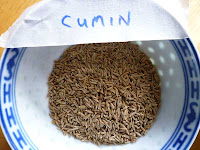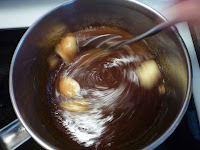Adapting Mini's Rye Ratio to my old starter
I have been wanting to try Mini's Rye Ratios ever since I first saw the posting about her breakthrough discovery of the 'right' ratio for rye on 'The Fresh Loaf Blogs'.
This is not it, but is an adaptation of her recipe to suit the needs of my day. One day, I will use her recipe with more exactitude. For now, this will have to do.
For today, I take some old starter (here is where I begin to diverge), at 75% hydration (another divergence) and considered that my weight standard ("one part rye starter"). To this, I added 3.5 parts water, and 4.16 parts flour, and salt at 1.8% of the flour's weight, as per Mini's ratio.
I am also adding someinstant dried yeast, (another divergence) because my starter is old. I'll go with 1% of the total flour mixture (i.e., the weight in grams that is 1% of the flour's weight added to the part of the weight of the starter that is rye flour.
I will also made my own bread spice, using the recipe she talks about elsewhere. Mini uses 4 TBSP of bread spice per 500g flour (that is, 1 TBSP:125g flour). I will use instead the ratio given in the recipe I found online for Brotgewürz, i.e. 5g per 1000g of flour.
The Bread Spice I Made
The bread spice is based loosely on the German Brotgewürz, a commercial product I have never tried. Mini gives her own recipe for bread spice elsewhere in the fresh loaf blogs, but that only uses fennel, coriander and caraway.
I found an online recipe that gives a recipe for a German bread spice (presumably for those who, like my wife, do not like caraway) at Germany's Recipe Wiki:
I did not have enough spices to make this as described. I made it in the same ratios, but instead of using tablespoons, I made it with teaspoons. This had a nice side-effect: once ground, it fits nicely in an old empty yeast jar.
The bread spice smells wonderful when you are crushing it in the mortar. The next time I make this, I think that I am going to also include some dried papaya seeds.
The bread spice is based loosely on the German Brotgewürz, a commercial product I have never tried. Mini gives her own recipe for bread spice elsewhere in the fresh loaf blogs, but that only uses fennel, coriander and caraway.
The spices in this Brotgewürz
I found an online recipe that gives a recipe for a German bread spice (presumably for those who, like my wife, do not like caraway) at Germany's Recipe Wiki:
- 10 tbsp whole cumin
- 6 tbsp anise
- 6 tbsp fennel seeds
- 2 tbsp coriander seeds
I did not have enough spices to make this as described. I made it in the same ratios, but instead of using tablespoons, I made it with teaspoons. This had a nice side-effect: once ground, it fits nicely in an old empty yeast jar.
The bread spice smells wonderful when you are crushing it in the mortar. The next time I make this, I think that I am going to also include some dried papaya seeds.
The first thing I did was to calculate some of the values of this table. These are huge amounts I am working with! I was originally going to use all of my spent sourdough, both rye and whole wheat, using these ratios. But it was not to be.
| Ingredient | ratio and overall% | Rye amount | Rye volume | Whole Wheat amount | Whole Wheat volume |
| Starter | 1 parts (%) | 466g | -- | 390g | -- |
| Flour | 4.16 parts (%) | 1939g | -- | 1622g | -- |
| Water | 3.5 parts (%) | 1631g | -- | 1365g | -- |
| Total Flour | 100% | 117g+1939g= 2056g | -- | 98g+1622g=1720g | -- |
| Salt | 1.8% of flour's wt | 37g- | -- | -31g | -- |
| ID Yeast | 1% of total flour's wt | 21g | -- | 17g | -- |
| Bread Spices | 0.5% of total flour's wt | 10g | -- | 9g | -- |
I didn't have enough rye flour to make all of this, so I decided to cut it in half. Even that looked like too much, so I cut it in half again. Finally I had what looked like the amounts I'd need for one loaf. And I decided that I won't make the whole wheat version this time, I'd just stick with the rye.
While fiddling with the table amounts, I encountered a little math problem that had me scratching my head for a while. This recipe brought up a strange problem (for me) in Baker's Math. Perhaps something like this has stopped other people too, so I'll reproduce it here in detail:
Baker's Math Problem:
You have a recipe that calls for a sourdough starter at 100% hydration.
You have a starter that is at 75% hydration.
You want to know how much flour is in the sourdough starter, so you can calculate the total amount of flour in the recipe (because that is what the other percentages in the recipe are going to be based on)
In my case, I knew only the total weight of the starter (117g), and its hydration (75%). That 75% means that the water weight is 75% of the flour weight in the starter. The flour in the starter is at 100%, obviously. And the weight of the flour is going to be the weight of the starter less the weight of the water.
The key to answering this problem is realizing that the starter actually contains more than 100% of ingredients. Always remember that the flour is 100%. So to get the total percentages of weights in the starter, add the percentages to the flour: it will always be greater than 100%. Bakers have to forget what they learned in school about the parts of the whole adding up to 100%. Just remember that with baking bread, the whole is always greater than the parts! You are creating something that contains more than 100%! Always!
So in this starter, the total percentages of the weights is 175%. How much of that is flour? It is going to be the total weight minus the weight of the water. The percentages are related to the weights. So let's set this up as a ratio. The only trick about setting up ratios is keeping what you are comparing on the same side of colon, for each side of the equal-sign. I'll show you what I mean:
75% water : 175% starter = x grams of water : 117grams starter
So this is (water to starter) on the left side of the equation, and (water to starter) on the right side. Set up in this way, you can then cross multiply.
175x = 75 X 117
x = 8775 / 175
= 50g
So the amount of flour would be 117g - 50g = 67g
You can test this out now to see if 50 g is 75% of 67g, also using ratios. Let's test for the weight of flour in grams, by calling that x. Thus:
75% : 100% = 50 grams : x grams
75x = 5000
x = 5000 / 75
= 67 grams.
Very simple once you have the key. So let's generalize a formula for the flour:
waterWt = (hydration% X totalStarterWt) / (hydration%+100)
starterFlourWt = totalStarterWt - waterWt
= totalStarterWt - ((hydration% X totalStarterWt) / (hydration% + 100))
I didn't have this formula in front of me for this experiment. But I will have it the next time I try to make Mini's Rye, officially.
Here's what I did:
Making the dough:
I mixed up 117g starter, 485g rye flour, 408g water, 9g salt, 5g yeast, and 3g bread spice. I didn't add the salt later, like Mini does. I just mixed it and it rested for 3 hours. Then I folded it a couple of times and shaped with wet hands into an oblong and placed it in a basket. There it rested for 4 hours.
Making the bread:
I preheated the oven and a casserole dish to 390 degrees F. 30 minutes later, I placed the dough inside the dish, splashed some yogurt on top, docked it with a fork, and baked for 25 minutes. Then I removed the lid and baked another 25 mites (I figured that, because of the yogurt, I should add a longer bake than Mini suggested in her recipe).
While I was taking a picture of this bread for the blog, the cat jumped up on the table and walked over to see what I was doing. I thought he was going to take a drink of water, but no, he was attracted to the bread. He went over to the bread -- which smells marvelous, by the way -- and licked the top of the loaf, once, where the yogurt is, before I could get the camera down and shoosh him off the table. The nerve of that cat.
The crumb is okay, nothing special, in fact it is very moist and although it tastes okay it could have used a slightly longer baking period, in my opinion. But it tastes very interesting, with the bread spice. I really like this. I ate some of it this morning, side by side with an old piece of rye bread that is going stale, and I decided that I like the taste of rye by itself, but that this rye flavour, with bread spice, makes for a nice change. It does change the whole character of a rye, slightly obscuring its bitter tones, but developing other personality traits. I'm glad I made the bread spice, and of course, the bread -- even though the bread was kind of a flop because I didn't actually follow Mini's recipe. I just needed a rye bread for work this weekend, and this recipe and my spent starter was at hand.
A bit misshapen, but a very interesting loaf
Notes to Myself
- Docking it and then dumping yogurt on top may have a counter effect. In this bread there was no great rise seen, only a sagging and spreading. Was that due to the heavy yogurt on top of the bread that prevented the bread from rising?
- The bread spices are actually quite nice, not too overpowering in this ratio. I think they do add something to the flavour. It is not something I would need all the time, but it is nice for a change. Wait and see if my wife likes it. She may not. I won't force her to try the bread this time, she gets cranky when I make her eat bread.
- This loaf could have benefited from an even longer baking, in my opinion. The crumb looks okay, and is moist, but in rye crumb, some moisture tends toward gumminess. I am just basing this on the fact that the knife did not come out clean when I first cut it. It tastes okay, not gummy.
- Harry the cat is attracted to the smell and the surface of this loaf. Keep it out of the reach of the cat.
- Be more attentive to Mini's directions and amounts when you next go to make this bread.
- I am not really sure why this simple bread math stumped me. My only explanation is that I was working on only 3 hours of sleep, in the flip-flop of going from working nights to days off. Get some sleep.































































